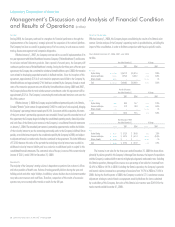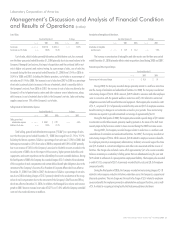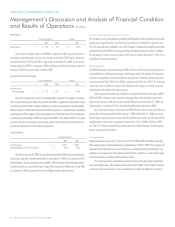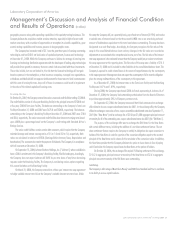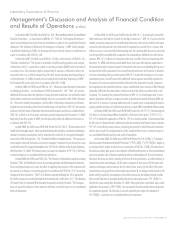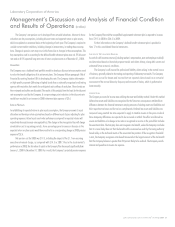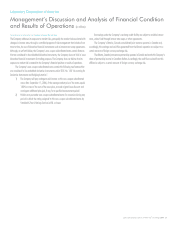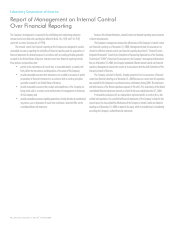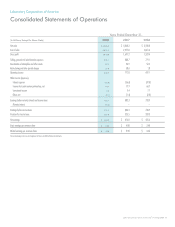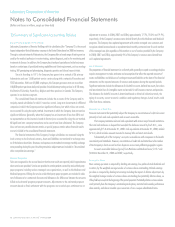LabCorp 2008 Annual Report Download - page 30
Download and view the complete annual report
Please find page 30 of the 2008 LabCorp annual report below. You can navigate through the pages in the report by either clicking on the pages listed below, or by using the keyword search tool below to find specific information within the annual report.28 Laboratory Corporation of America® Holdings 2008
Management’s Discussion and Analysis of Financial Condition
and Results of Operations (in millions)
Laboratory Corporation of America
Forward-Looking Statements
The Company has made in this report, and from time to time may otherwise make in its public
filings, press releases and discussions by Company management, forward-looking statements
concerning the Company’s operations, performance and financial condition, as well as its
strategic objectives. Some of these forward-looking statements can be identified by the use of
forward-looking words such as “believes,” “expects,” “may,” “will,” “should,” “seeks,”
“approximately,” “intends,” “plans,” “estimates,” or “anticipates” or the negative of those
words or other comparable terminology. Such forward-looking statements are subject to various
risks and uncertainties and the Company claims the protection afforded by the safe harbor for
forward-looking statements contained in the Private Securities Litigation Reform Act of 1995.
Actual results could differ materially from those currently anticipated due to a number of factors
in addition to those discussed elsewhere herein and in the Company’s other public filings,
press releases and discussions with Company management, including:
1. changes in federal, state, local and third-party payer regulations or policies (or in the
interpretation of current regulations) affecting governmental and third-party coverage
or reimbursement for clinical laboratory testing;
2. adverse results from investigations of clinical laboratories by the government, which
may include significant monetary damages and/or exclusion from the Medicare and
Medicaid programs;
3. loss or suspension of a license or imposition of a fine or penalties under, or future
changes in, or interpretations of, the law or regulations of the Clinical Laboratory
Improvement Act of 1967, and the Clinical Laboratory Improvement Amendments of
1988, or those of Medicare, Medicaid, the False Claims Act or other federal, state
or local agencies;
4. failure to comply with the Federal Occupational Safety and Health Administration
requirements and the Needlestick Safety and Prevention Act, which may result in
penalties and loss of licensure;
5. failure to comply with HIPAA, including changes to federal and state privacy and
security obligations and changes to HIPAA, which could result in increased costs,
denial of claims and/or significant fines;
6. failure of third-party payers to complete testing with the Company, or accept or remit
transactions in HIPAA-required standard transaction and code set format, (including
NPI), which could result in an interruption in the Company’s cash flow;
7. increased competition, including competition from companies that do not comply with
existing laws or regulations or otherwise disregard compliance standards in the industry;
8. increased price competition, competitive bidding for laboratory tests and/or changes
or reductions to fee schedules;
9. changes in payer mix, including an increase in capitated managed-cost health care
or the impact of a shift to consumer-driven health plans;
10. failure to obtain and retain new customers and alliance partners, or a reduction in
tests ordered or specimens submitted by existing customers;
11. failure to retain or attract managed care business as a result of changes in business
models, including new risk based or network approaches, or other changes in strategy
or business models by managed care companies;
12. failure to effectively integrate and/or manage newly acquired businesses and the cost
related to such integration;
13. adverse results in litigation matters;
14. inability to attract and retain experienced and qualified personnel;
15. failure to maintain the Company’s days sales outstanding and/or bad debt expense levels;
16. decrease in the Company’s credit ratings by Standard & Poor’s and/or Moody’s;
17. discontinuation or recalls of existing testing products;
18. failure to develop or acquire licenses for new or improved technologies, or if customers
use new technologies to perform their own tests;
19. inability to commercialize newly licensed tests or technologies or to obtain appropriate
coverage or reimbursement for such tests, which could result in impairment in the
value of certain capitalized licensing costs;
20. changes in government regulations or policies affecting the approval, availability of,
and the selling and marketing of diagnostic tests;
21. inability to obtain and maintain adequate patent and other proprietary rights for
protection of the Company’s products and services and successfully enforce the
Company’s proprietary rights;
22. the scope, validity and enforceability of patents and other proprietary rights held
by third parties which might have an impact on the Company’s ability to develop,
perform, or market the Company’s tests or operate its business;
23. failure in the Company’s information technology systems resulting in an increase in
testing turnaround time or billing processes or the failure to meet future regulatory
or customer information technology and connectivity requirements;
24. failure of the Company’s financial information systems resulting in failure to meet
required financial reporting deadlines;
25. failure of the Company’s disaster recovery plans to provide adequate protection against
the interruption of business and/or to permit the recovery of business operations;
26. business interruption or other impact on the business due to adverse weather (including
hurricanes), fires and/or other natural disasters and terrorism or other criminal acts;
27. liabilities that result from the inability to comply with corporate governance requirements;
28. significant deterioration in the economy or financial markets could negatively impact
the Company’s testing volumes, cash collections and the availability of credit for
general liquidity or other financing needs; and
29. changes in reimbursement by foreign governments and foreign currency fluctuations.




